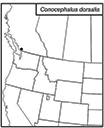|
Alien origin and spread of this SINA species.
|
|
Identification:
|
This species is easily recognized by the short wings, brown stripe down the dorsal abdomen, form of the male cerci, and curved ovipositor of the female.
|
|
Habitat:
|
Most individuals found in North America have been in seasonally wet fields dominated by non-native grasses. The Victoria records come from a constructed wetland with native sedges and rushes. One individual in Vancouver was photographed in an urban setting with no vegetation except small plantings of ornamental shrubs. Habitat in the native range includes wet meadows and tidal marshes.
|
|
Season:
|
Adults have been collected from mid-August to late September.
|
|
Song:
|
The song is very quiet. People with acute hearing can detect the song only within a few metres of the singer. A recording is available at OSF.
|
|
Similar species:
|
The only similar species overlapping with the current North American range of C. dorsalis is C. fasciatus. That species has longer wings, a different pattern of stripes on the abdomen, male cerci with smaller inner tooth, and straight female ovipositor.
|
|
Remarks:
|
This species was first recorded at a few islands in the Delta of the Fraser River in 2008. Since then it has been found in the nearby city of Vancouver and 65 km away in the city of Victoria. It is likely that it also occurs in adjacent Washington State. At most locations, C. dorsalis is greatly outnumbered by C. fasciatus.
|
|
More information:
|
Subfamily Conocephalinae, genus Conocephalus.
|
|
References:
|
Miskelly, J. 2013. Pan-Pacific Entomologist 89(1):69-71.
|
|
Nomenclature:
|
OSF (Orthoptera Species File Online).
|









